Xianling Mausoleum: Where Legends of Chinese Emperors Come Alive
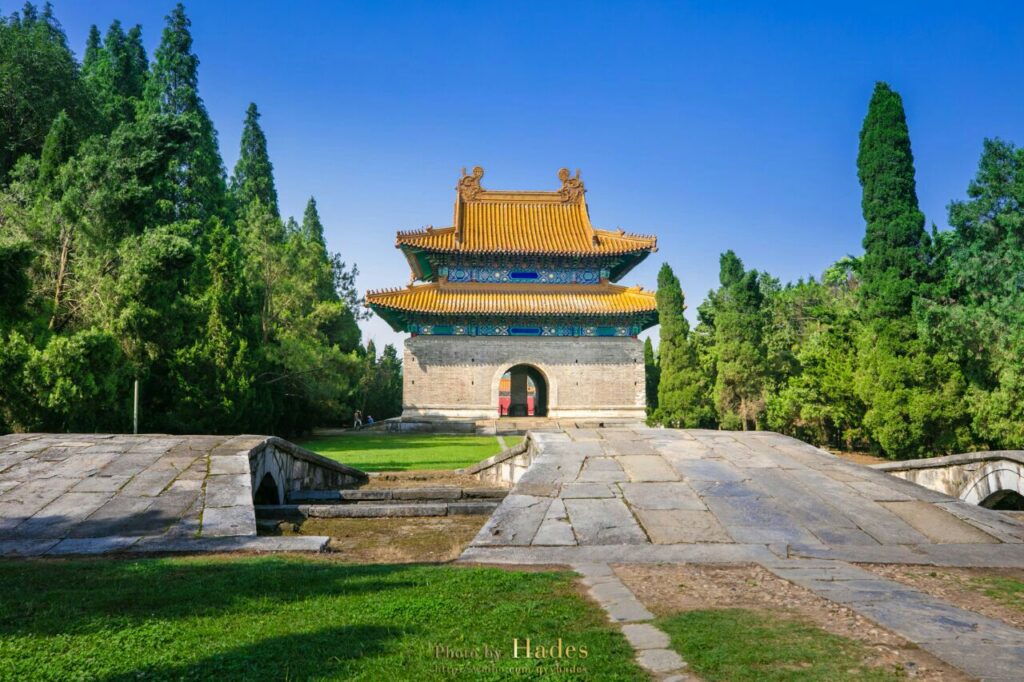
An Essential Guide to Visiting Xianling Mausoleum
In This Guide
- An Essential Guide to Visiting Xianling Mausoleum
- The Rich History and Legends of Xianling Mausoleum
- Main Highlights: What You Absolutely Can’t Miss
- Planning Your Visit: A Practical Guide
- Tickets: Prices, Booking, and Tips
- How to Get There: A Complete Transportation Guide
- Local Cuisine and Accommodation Nearby
- Frequently Asked Questions
- Final Thoughts on Your Trip
Visiting the Xianling Mausoleum is like stepping into the pages of history, where tales of love, power, and reverence intertwine. Located approximately 87 kilometers northwest of Xi’an, this grand burial site serves as the eternal resting place of Emperor Gaozong (Li Zhi) and his formidable wife, Empress Wu Zetian—the only female emperor in Chinese history. The mausoleum is not merely a tomb; it is a testament to the Tang Dynasty’s grandeur, intricately woven into the fabric of China’s rich cultural heritage.
As you approach the mausoleum, you are greeted by the majestic Liangshan Mountain, with its peaks offering a natural backdrop that enhances the solemnity and beauty of the site. The Qianling Mausoleum is famed for its impressive Spirit Way, lined with an open-air museum of stone statues, including the enigmatic headless figures of foreign officials that hint at China’s vibrant diplomatic history.
With a layout mirroring that of ancient Chang’an (modern-day Xi’an), the mausoleum complex is expansive and meticulously designed, providing a glimpse into the architectural prowess of the Tang Dynasty. The presence of the Wordless Tablet, a stele devoid of any inscriptions, adds an air of mystery and intrigue, inviting visitors to ponder the legacy of Empress Wu Zetian.
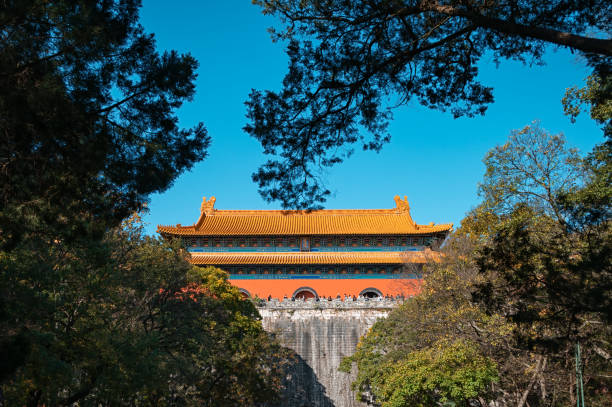
Xianling Mausoleum.
Whether you are a history enthusiast wanting to delve into the captivating stories of the past or a photography lover eager to capture the stunning landscapes and intricate sculptures, the Xianling Mausoleum promises an unforgettable experience. Prepare to be enchanted by the rich history and cultural significance that this site has to offer.
The Rich History and Legends of Xianling Mausoleum
Nestled in the verdant embrace of Liangshan Mountain, the Xianling Mausoleum stands as a testament to the grandeur of the Tang Dynasty, immortalizing the intertwined destinies of two of its most notable figures: Emperor Gaozong and Empress Wu Zetian. This site is not just a resting place for the illustrious couple but a narrative of ambition, power, and the complexities of love that shaped a significant era in Chinese history.
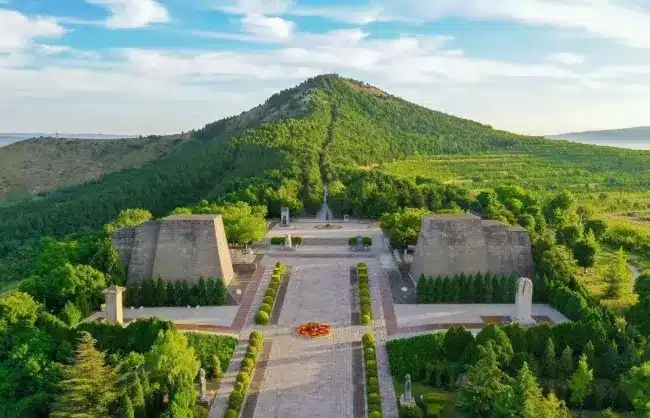
Xianling Mausoleum.
A Unique Imperial Legacy
Unlike any other mausoleum in China, the Xianling Mausoleum is the only imperial tomb that houses both a husband and wife, making it an extraordinary site for those fascinated by royal history. Emperor Gaozong, known for his consolidation of power during the Tang Dynasty, took Wu Zetian as his consort. Initially serving as a pivotal advisor, Wu Zetian’s political acumen enabled her to ascend to the throne herself, a feat unmatched in Chinese history. After Gaozong’s death, Wu Zetian ruled for 15 years, ultimately establishing the Zhou Dynasty. This unique partnership is emblematic of the power dynamics and the roles women could assume in ancient China.
Legends and Myths
The mausoleum is steeped in legends that reflect the enigmatic character of Empress Wu Zetian. One of the most intriguing tales revolves around the Wordless Tablet, a blank stele erected by Wu herself. It is said that she intended it as a silent testament to her legacy—leaving it blank for future generations to judge her reign. This act reflects her profound understanding of power and the transient nature of history. Over the years, the tablet has accumulated scratches and scrawls, remnants of public opinion from the Northern Song Dynasty to the Qing Dynasty, making it a canvas of both reverence and critique.
Architectural Marvel
The mausoleum’s design is a marvel in itself, echoing the layout of ancient Chang’an (modern-day Xi’an), with its inner and outer city walls. The majestic Spirit Way, adorned with over 100 stone statues, serves as a gateway to the afterlife, showcasing the vibrant diplomatic ties of the Tang Dynasty through the inclusion of 61 headless stone statues of foreign officials. These figures are not merely decorative; they tell stories of alliances and diplomacy, capturing the essence of an era where China was at the zenith of cultural exchange.
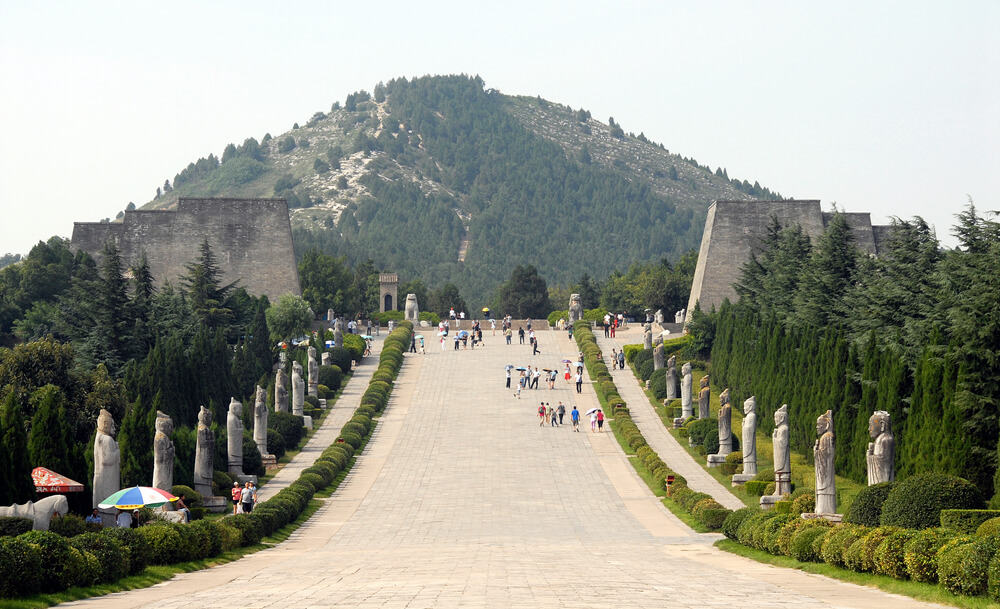
Xianling Mausoleum.
The Accompanying Tombs
Surrounding the main tomb are 17 accompanying tombs, where members of the royal family and important ministers rest. The tomb of Princess Yongtai, in particular, offers a glimpse into the opulence of Tang royal life, with exquisite murals depicting competitive sports, hunting, and courtly activities. Visitors can explore these satellite tombs, which have been opened to the public, and witness the artistry of the Tang Dynasty firsthand.
Cultural Significance
The Xianling Mausoleum serves as an open-air museum of history, culture, and artistry. The collection of artifacts housed in the Qianling Museum, including tri-colored glazed pottery and terracotta figures, further contextualizes the legacy of the Tang Dynasty. This site is a must-visit for those who wish to delve deeper into the complexities of Chinese history, especially the remarkable story of its only female emperor.
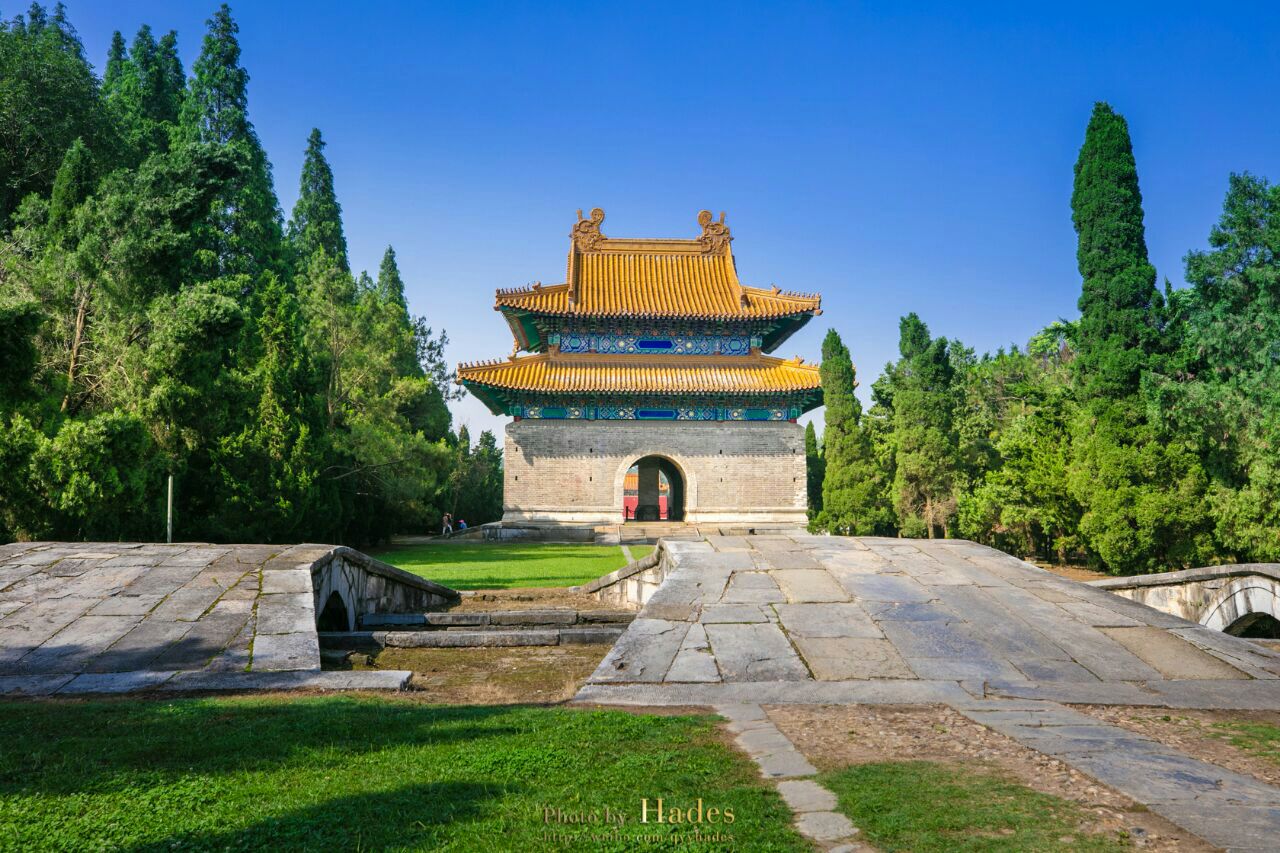
Xianling Mausoleum.
Conclusion
The Xianling Mausoleum is more than just a burial site; it is a rich tapestry of history, legends, and cultural significance. For those seeking to understand the intricacies of ancient Chinese civilization, a visit to this mausoleum promises a journey through time, revealing the stories of love, power, and resilience that continue to resonate in contemporary culture. As you stroll along the Sacred Way, surrounded by the majestic mountain backdrop, you cannot help but feel the weight of history and the legacy of two extraordinary rulers etched into the very stones of this magnificent site.
Main Highlights: What You Absolutely Can’t Miss
Discover the Unmissable Highlights of Qianling Mausoleum
Embark on a journey through history at the Qianling Mausoleum, a captivating site that offers a unique glimpse into the lives of Emperor Gaozong and his wife, the formidable Empress Wu Zetian, China’s only female emperor. Nestled amidst the serene Liangshan Mountains, this mausoleum is not only a burial site but a testament to the grandeur of the Tang Dynasty. Here are the key highlights you simply cannot miss:
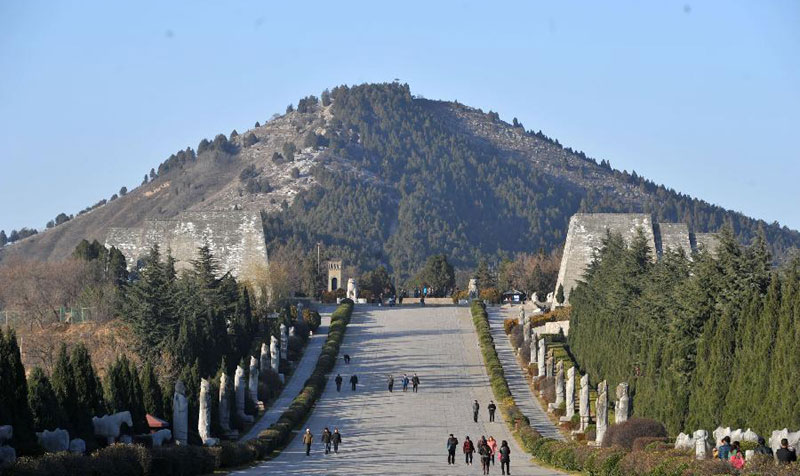
Xianling Mausoleum.
1. The Sacred Way and Stone Statues
As you approach the mausoleum, the Sacred Way stretches before you, adorned with 124 vivid stone statues that create an open-air museum of Tang Dynasty artistry. The statues, representing officials, animals, and foreign envoys, provide insight into the diplomatic relations of the era. Among them, the 61 headless stone statues of foreign officials stand testament to the respect and recognition extended to the Tang Dynasty by various nations.
2. The Enigmatic Wordless Tablet
At the heart of Empress Wu Zetian’s tomb lies the Wordless Tablet, a stark yet thought-provoking monument. With no inscriptions, it invites speculation about Wu’s legacy. It is believed she desired future generations to judge her merits and faults without her influence. Despite its blank face, the tablet bears the marks of history, with scratches left by visitors over centuries, adding to its mystique.
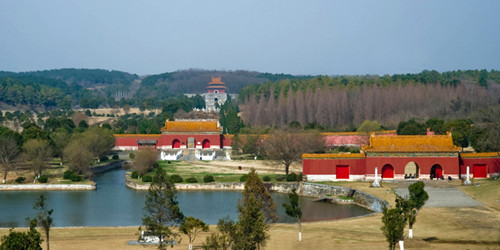
Xianling Mausoleum.
3. Giant Stone Steles
In front of the mausoleum, two monumental steles capture attention. The Stone Stele Dedicated to Emperor Gaozong stands tall, inscribed with a lengthy epitaph praising his virtues, while the Wordless Stone Stele serves as a haunting reminder of Wu Zetian’s complex legacy. Together, they encapsulate the profound respect and historical significance attributed to the couple.
4. Accompanying Tombs and the Qianling Museum
Nearby, the 17 accompanying tombs reveal more about the royal family and the Tang court. Notable among them is the Tomb of Princess Yongtai, which showcases exquisite murals depicting royal life and activities, such as sports and hunting. The adjacent Qianling Museum houses over 820 artifacts, including Tang tri-colored glazed pottery and exquisite jewelry, providing a rich context for understanding the era’s culture.
5. Scenic Integration with Nature
The mausoleum is harmoniously integrated into the landscape of Liangshan Mountain, with the main tomb cleverly concealed within the hills. The approach involves a staircase of 537 stone steps that leads you through a breathtaking natural setting, enhancing the sense of reverence as you approach this historical site.
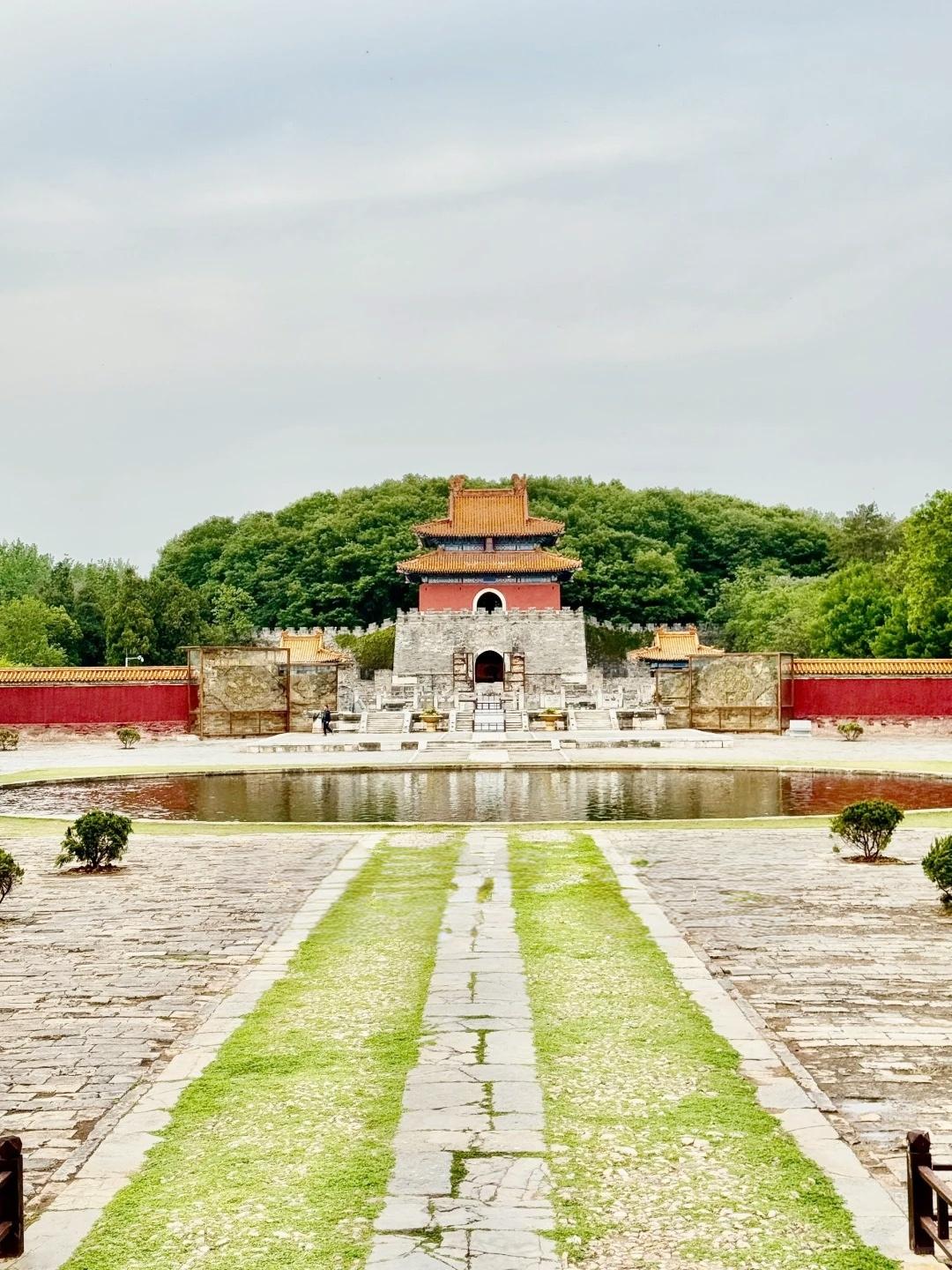
Xianling Mausoleum.
6. Architectural Layout Reflecting Chang’an
The layout of Qianling Mausoleum mirrors the ancient city of Chang’an, with distinct inner and outer city walls. This architectural choice not only signifies the importance of the site but also provides a glimpse into the urban planning of the Tang Dynasty, making it a fascinating point of exploration for history enthusiasts.
7. Visiting Practicalities
Plan your visit wisely to ensure you experience all that Qianling Mausoleum has to offer. The site is expansive, and purchasing a sightseeing bus ticket (CNY 30) can save you time and energy. The best months to visit are April through June and September through October when the weather is most pleasant for exploration.
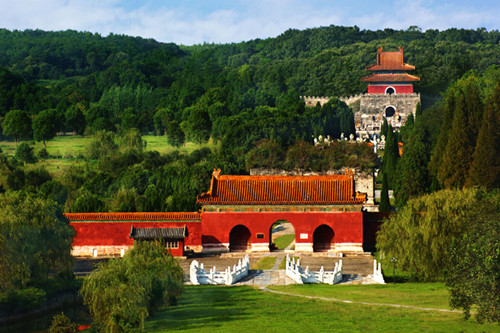
Xianling Mausoleum.
Conclusion
The Qianling Mausoleum is not merely a burial ground but a storied landmark that offers profound insights into the lives of two of China’s most influential figures. Each highlight invites you to delve deeper into the legacy of the Tang Dynasty and the remarkable narratives that shaped its history. Don’t miss this opportunity to walk through time at one of China’s most significant historical sites!
Planning Your Visit: A Practical Guide
Essential Guide for Your Visit to Qianling Mausoleum
Nestled in the serene foothills of Liangshan Mountain, the Qianling Mausoleum, located approximately 87 kilometers northwest of Xi’an, offers an unparalleled glimpse into China’s rich Tang Dynasty history. As the joint burial site of Emperor Gaozong and Empress Wu Zetian, the only female emperor in China’s history, this site is a treasure trove of historical significance and cultural heritage. Here’s everything you need to know to make the most of your visit.
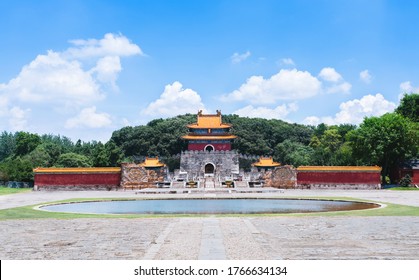
Xianling Mausoleum.
Getting There
By High-Speed Train:
– Start your journey at Xi’an North Railway Station.
– Board a high-speed train to Qianxian. The ride takes around 30 minutes.
– After arriving at Qianxian Station, transfer to Bus No. 1 to Yaojiagong Lukou or Bus No. 2 to Yaojiagong.
By Car:
– If you prefer driving, the mausoleum is roughly a 1.5-hour drive from downtown Xi’an. Follow the signs leading to Qianling Mausoleum, which is well-marked.
Opening Hours and Tickets
- Opening Hours:
- March – November: 8:00 AM – 6:00 PM
-
December – February: 8:30 AM – 5:30 PM
-
Admission Fees:
- Peak Season (March – November): CNY 100
- Low Season (December – February): CNY 80
- Sightseeing Bus Ticket: CNY 30
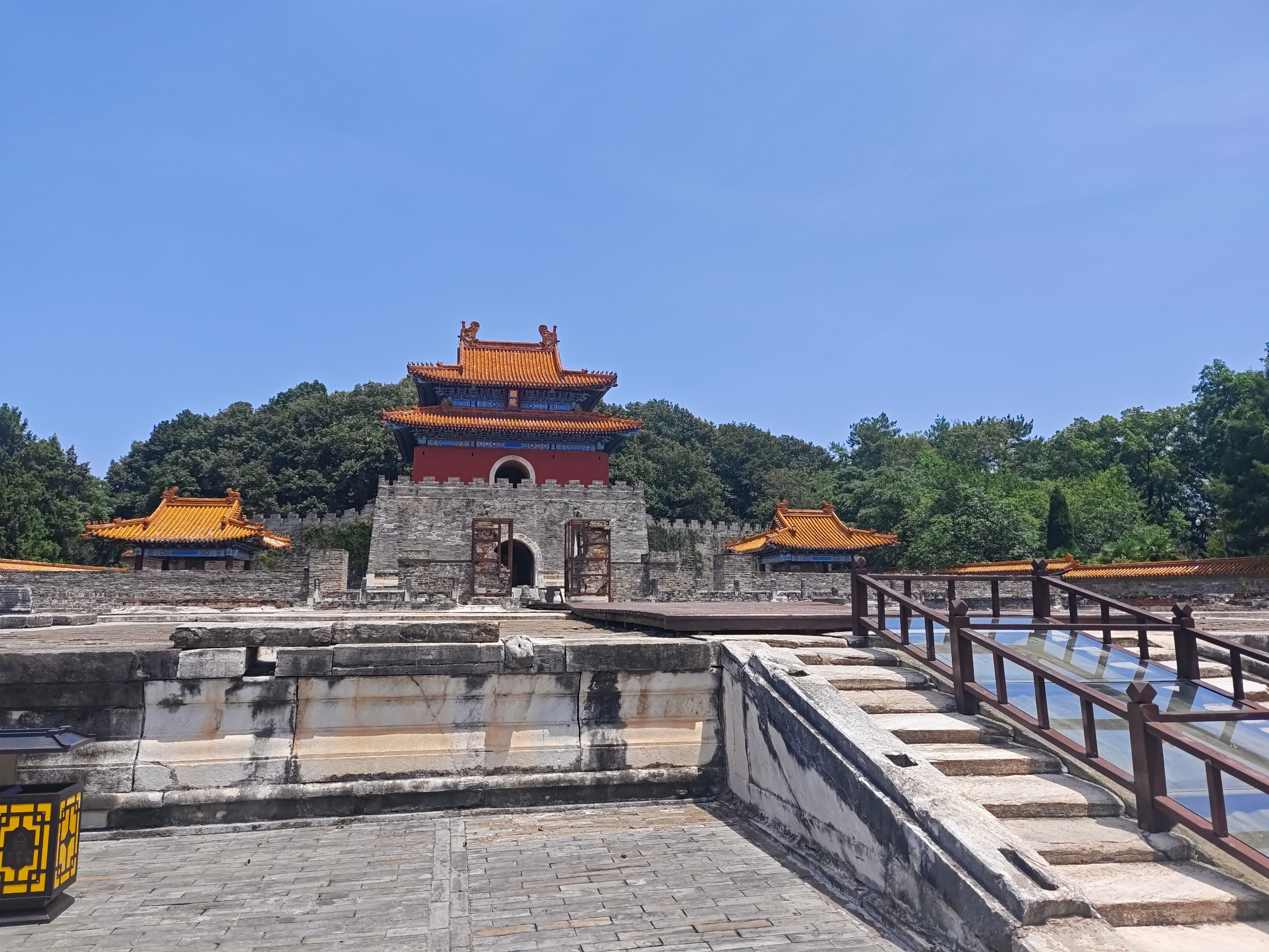
Xianling Mausoleum.
What to See
Key Highlights:
1. Spirit Way Stone Statues: A stunning 700-meter path lined with 124 stone statues, including the notable 61 Headless Stone Statues of Foreign Officials.
2. Wordless Tablet: This enigmatic stele, erected by Empress Wu Zetian, invites visitors to consider her legacy without her own words.
3. Giant Steles: The Stone Stele Dedicated to Emperor Gaozong stands as a testament to his achievements, while the Wordless Stone Stele remains a blank canvas for historical interpretation.
4. Qianling Museum: Home to over 820 artifacts, this museum showcases treasures unearthed from the accompanying tombs, including Tang tri-colored pottery and intricate jewelry.
Touring Tips
- Transportation: Given the vast area of the mausoleum (2.3 sq km), it is advisable to purchase the sightseeing shuttle ticket to save energy and time.
- Recommended Route: Start from the South Gate, proceed along the Sacred Way, visit the Wordless Tablet, explore the satellite tombs, and return.
- Plan for Stairs: Many of the tombs have steep staircases, such as the 18-meter deep Princess Yongtai’s Tomb.
Best Time to Visit
For optimal weather and beautiful scenery, consider visiting during April to June or September to October. These months provide pleasant temperatures and vibrant surroundings that enhance your experience.
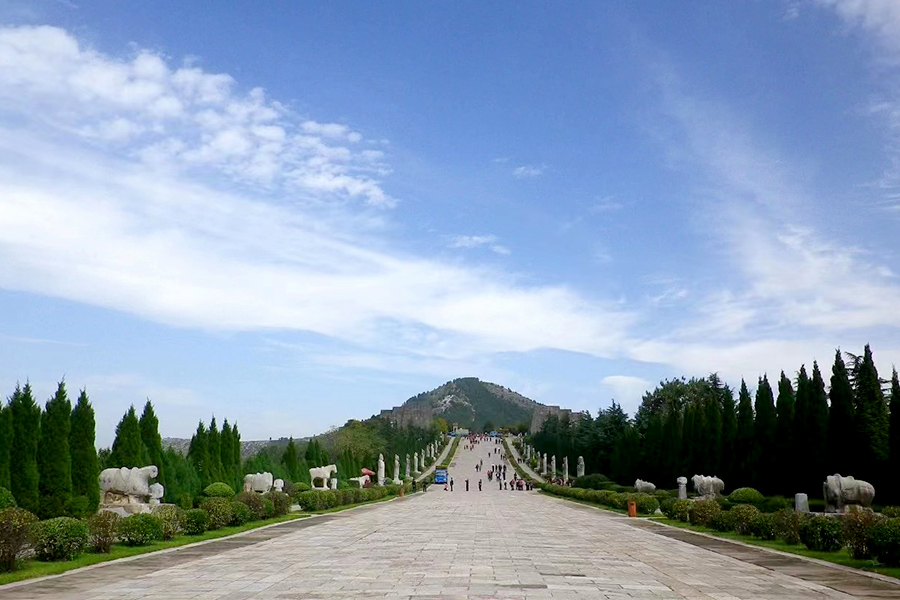
Xianling Mausoleum.
Nearby Attractions
After visiting Qianling Mausoleum, you might also want to explore:
– Famen Temple: A site of historical and religious significance.
– Xi’an Museum: Offers further insight into the region’s rich history.
Practical Considerations
- Photography: Flash photography is prohibited in certain areas, such as the murals in Princess Yongtai’s Tomb, to protect the delicate art.
- Cultural Respect: As you navigate the mausoleum, remember that these sites hold great historical significance. Respectful behavior will enhance your experience and that of fellow visitors.
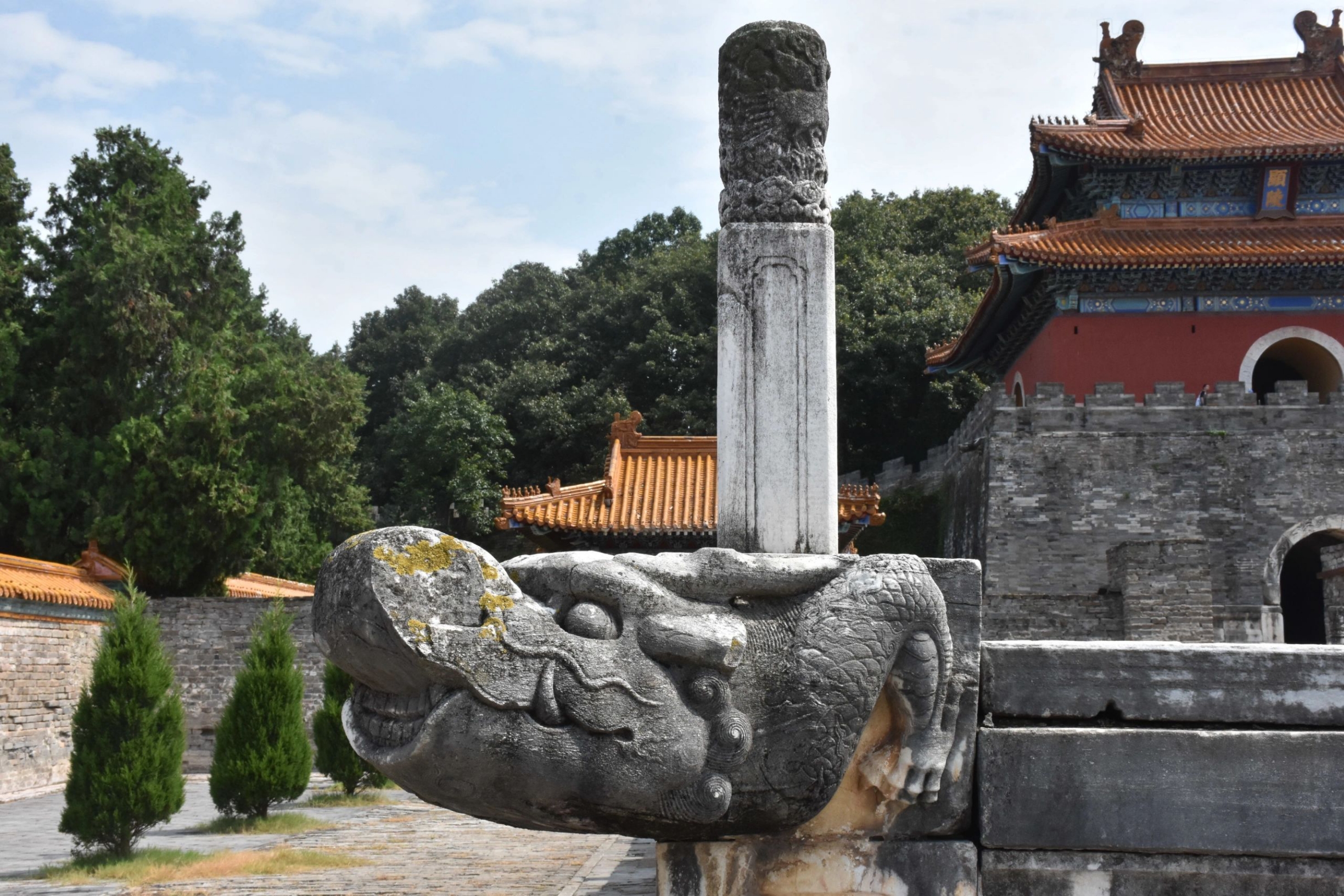
Xianling Mausoleum.
By immersing yourself in the rich history of Qianling Mausoleum, you will gain a deeper understanding of the Tang Dynasty’s legacy and the unique story of Empress Wu Zetian. Prepare for a journey through time that is as enlightening as it is inspiring!
Tickets: Prices, Booking, and Tips
Discovering the Qianling Mausoleum: Ticketing Information and Helpful Tips
Visiting the Qianling Mausoleum, the grand burial site of Emperor Gaozong and the only female emperor in Chinese history, Empress Wu Zetian, offers an exceptional glimpse into ancient China’s rich history. To ensure your visit is as smooth as possible, here’s a detailed guide on ticket prices, booking methods, and practical tips for your journey.
Ticket Prices
- General Admission:
- Peak Season (March – November): CNY 100
- Low Season (December – February): CNY 80
- Sightseeing Bus: CNY 30
These tickets grant access to the main mausoleum, the Tomb of Princess Yongtai, the Tomb of Prince Zhanghuai (Li Xian), the Tomb of Prince Yide, and the Qianling Museum, where you can explore over 820 excavated artifacts.
Booking Your Tickets
Tickets can usually be purchased at the entrance of the mausoleum. However, during peak tourist seasons, it’s advisable to arrive early to avoid long lines. If you prefer convenience, consider using a travel agency or an online booking platform that offers tickets in advance, ensuring you secure your entry without any hassle.
Opening Hours
- March – November: 8:00 AM – 6:00 PM
- December – February: 8:30 AM – 5:30 PM
Best Times to Visit
For an optimal experience, plan your trip during the months of April to June or September to October. These months typically feature pleasant weather, making your exploration of the expansive grounds much more enjoyable.
Transportation to Qianling Mausoleum
To reach the mausoleum from Xi’an city center:
1. High-Speed Train: Take a train from Xi’an North Railway Station to Qianxian, which takes about 30 minutes.
2. Public Bus: After arriving at Qianxian Station, transfer to bus no. 1 or bus no. 2 to reach the mausoleum.
Tips for a Smooth Visit
- Consider a Shuttle Bus: The mausoleum covers an expansive area of approximately 2.3 sq km. To conserve energy, purchasing a sightseeing shuttle ticket for CNY 30 is highly recommended.
- Prepare for Steep Staircases: Some underground tombs, such as Princess Yongtai’s tomb, feature steep staircases. Be prepared for a bit of a climb!
- Photography Restrictions: Flash photography is prohibited in certain areas, particularly in the “Palace Maidens” mural within Princess Yongtai’s Tomb, so be mindful while capturing memories.
- Combine Your Visit: If you have time, consider visiting nearby attractions like Famen Temple or Hanyangling Mausoleum to enrich your cultural experience.
By following this guide, you’ll be well-equipped to enjoy the historical wonders of the Qianling Mausoleum and appreciate the profound significance of this royal burial site in Chinese history.
How to Get There: A Complete Transportation Guide
To explore the fascinating Qianling Mausoleum and immerse yourself in the captivating history of Emperor Gaozong and Empress Wu Zetian, understanding how to get there is paramount. This guide will provide you with comprehensive transportation options to ensure your visit is smooth and enjoyable.
Getting to Qianling Mausoleum from Xi’an
1. By High-Speed Train:
One of the most efficient and comfortable ways to reach Qianling Mausoleum is by utilizing the high-speed rail network. Here’s how:
- Departure: Start your journey at Xi’an North Railway Station.
- Train Duration: The high-speed train ride to Qianxian Station takes approximately 30 minutes.
- Transfer to Bus: Upon arriving at Qianxian Station, take either Bus No. 1 to Yaojiagong Lukou or Bus No. 2 to Yaojiagong. The bus ride will take about 30-40 minutes.
2. By Private Vehicle:
For those preferring the flexibility of a private vehicle, you can drive or hire a taxi:
- Distance: Qianling Mausoleum is located about 87 kilometers northwest of downtown Xi’an.
- Travel Time: Expect a driving time of around 1.5 hours depending on traffic conditions.
- Route: Follow the G108 National Road or the S107 Provincial Road for a scenic drive through the Shaanxi countryside.
3. By Organized Tours:
Many travel agencies offer guided tours to Qianling Mausoleum, often combined with other historical sites in the region. This option typically includes:
- Transportation: Round-trip transportation from your hotel in Xi’an.
- Guided Experience: A knowledgeable guide who will provide insights into the history and significance of the mausoleum during your visit.
Inside Qianling Mausoleum
Once you arrive at the Qianling Mausoleum, navigating the expansive site is key to making the most of your visit:
-
Sightseeing Shuttle: The mausoleum area spans 2.3 square kilometers. To conserve energy, consider purchasing a sightseeing shuttle ticket for CNY 30. This will allow you to hop on and off at various key locations without the strain of walking long distances.
-
Recommended Route: A suggested touring path would be:
- South Gate
- Sacred Way Stone Statues
- Wordless Tablet
- Shushengji Stele
- Princess Yongtai’s Tomb
- Crown Prince Zhanghuai’s Tomb
- Crown Prince Yide’s Tomb
- Return to South Gate
Practical Tips for Your Journey
- Best Time to Visit: Plan your trip during the months of April to June or September to October for pleasant weather and stunning scenery.
- Ticket Prices: Entrance fees are CNY 100 during peak season (March to November) and CNY 80 in the low season (December to February). The ticket grants access to the mausoleum and several accompanying tombs and museums.
- Accessibility: Be prepared for steep staircases, especially in underground chambers. If you have mobility issues, consider informing your tour operator beforehand.
Nearby Attractions
Consider pairing your visit to Qianling Mausoleum with nearby historical sites such as:
- Famen Temple: Renowned for its ancient relics and stunning architecture.
- Xianyang Museum: An excellent place to delve into the rich history of the region.
By adhering to this transportation guide, you will not only reach Qianling Mausoleum with ease but also enhance your appreciation of one of China’s most significant historical sites. Enjoy your journey through time at the magnificent resting place of two of China’s most compelling imperial figures!
Local Cuisine and Accommodation Nearby
When visiting the Qianling Mausoleum, not only can you immerse yourself in the rich history of the Tang Dynasty, but you can also indulge in the exquisite local cuisine and find comfortable accommodations nearby. Here are some recommendations to enhance your travel experience.
Local Cuisine
1. Shaanxi Noodles (油泼面, You Po Mian)
A visit to this region would be incomplete without trying the famous Shaanxi noodles. These hand-pulled noodles are typically tossed in a spicy oil sauce and topped with fresh vegetables, making for a delightful and hearty dish.
2. Rou Jia Mo (肉夹馍)
Often referred to as Chinese hamburgers, Rou Jia Mo features slow-cooked, seasoned meat stuffed into a freshly baked flatbread. It’s a popular street food that’s both filling and flavorful, perfect for a quick bite after exploring the mausoleum.
3. Yangrou Paomo (羊肉泡馍)
This traditional dish consists of a rich mutton broth served with crumbled flatbread. It’s a comforting meal, especially in cooler weather, and gives you a taste of local culinary traditions that date back centuries.
4. Dumplings (饺子, Jiaozi)
Shaanxi is known for its dumplings, often served in a variety of fillings, from pork to vegetables. These are typically enjoyed with vinegar and garlic dipping sauce, providing a burst of flavor with each bite.
5. Huang Guo Luo (黄果萝)
For dessert, try this sweet and soft cake made with glutinous rice and filled with red bean paste. It’s a delightful way to end your meal and provides a taste of local sweetness.
Accommodation Nearby
1. Qianling Hotel
Located just a short drive from the mausoleum, Qianling Hotel offers comfortable rooms with modern amenities. The hotel features a restaurant serving local delicacies, and its proximity to the site makes it an ideal choice for history enthusiasts.
2. Xi’an Qianling International Hotel
This upscale hotel provides a luxurious stay with spacious rooms and excellent services. Guests can enjoy a variety of dining options, including authentic Shaanxi cuisine, and the hotel is well-situated for easy access to the Qianling Mausoleum and other local attractions.
3. Huashan International Hotel
Offering a blend of traditional Chinese hospitality and contemporary comforts, this hotel provides great service and is conveniently located near public transportation options. It’s a great base for exploring not just the mausoleum but also the greater Xi’an region.
4. Budget Options: Hostels and Guesthouses
For travelers on a budget, several hostels and guesthouses are available in nearby towns. These provide a more intimate experience, often allowing guests to interact with locals and gain deeper insights into the culture. Look for options that highlight local dishes in their dining services to enhance your culinary journey.
Conclusion
Embrace the culinary delights and comfortable accommodations that the Qianling Mausoleum area has to offer. Whether you’re savoring a bowl of hand-pulled noodles or resting in a cozy hotel room, your experience will be enriched by the flavors and hospitality of this historic region.
Frequently Asked Questions
Frequently Asked Questions about Qianling Mausoleum
1. What makes Qianling Mausoleum unique compared to other Chinese tombs?
Qianling Mausoleum stands out as the only imperial burial site in China that houses both a husband and wife—Emperor Gaozong and Empress Wu Zetian, the latter being the only female emperor in Chinese history. Unlike the Terracotta Army, which emphasizes military might, Qianling reflects the rich cultural and diplomatic legacy of the Tang Dynasty.
2. What are the must-see attractions within the mausoleum?
Visitors should not miss the following highlights:
– Spirit Way: A 700-meter path adorned with 124 stone statues, including the headless figures of 61 foreign officials.
– Wordless Tablet: A striking blank stele erected by Empress Wu, inviting future generations to judge her legacy.
– Giant Steles: Dedicated to Emperor Gaozong and Empress Wu, both featuring intricate carvings and historical inscriptions.
– Satellite Tombs: Notably, the Tomb of Princess Yongtai, which showcases exquisite murals and artifacts.
3. Can I access the underground tomb chambers?
While the main tombs of Emperor Gaozong and Empress Wu Zetian are sealed and not accessible to the public, several accompanying satellite tombs, such as those of Princess Yongtai and Prince Yide, are open for exploration. These tombs provide a fascinating glimpse into Tang Dynasty life through their vibrant murals and relics.
4. Are there ongoing archaeological excavations at Qianling?
Currently, the central tomb remains closed to protect its cultural relics, but archaeological work continues in the surrounding satellite tombs. Significant discoveries, including tri-colored pottery and murals, have been unearthed, contributing to our understanding of this historical period.
5. How do I get to Qianling Mausoleum from Xi’an city center?
Traveling to Qianling Mausoleum is convenient via high-speed rail. You can take a train from Xi’an North Railway Station to Qianxian (approximately a 30-minute ride). From Qianxian Station, transfer to local buses for the final leg of your journey.
6. What is the best time to visit Qianling Mausoleum?
The ideal months for visiting are April to June and September to October, when the weather is pleasant and the scenery is particularly beautiful. It’s advisable to avoid the peak summer months for a more comfortable experience.
7. Are there any travel tips for visiting Qianling Mausoleum?
To make the most of your visit:
– Consider purchasing a sightseeing shuttle ticket (CNY 30) to navigate the large area more comfortably.
– Be aware that some tomb chambers have steep staircases, so wear comfortable footwear.
– Flash photography is prohibited in certain areas, like the “Palace Maidens” mural in Princess Yongtai’s Tomb.
8. Is there an admission fee for Qianling Mausoleum?
Yes, the ticket price is CNY 100 during the peak season (March to November) and CNY 80 in the low season (December to February). This fee includes access to the main mausoleum, the satellite tombs, and the Qianling Museum, which showcases numerous excavated artifacts.
Final Thoughts on Your Trip
As your journey to the Qianling Mausoleum comes to an end, take a moment to reflect on the rich tapestry of history and culture that envelops this extraordinary site. Nestled within the picturesque Liangshan Mountain, the mausoleum is not just an architectural marvel, but a poignant reminder of the powerful legacy left by Emperor Gaozong and the indomitable Empress Wu Zetian, the only female emperor in Chinese history.
Embrace the Legacy
Exploring the Qianling Mausoleum offers you a unique insight into the grandeur of the Tang Dynasty, where art, diplomacy, and power coalesced in a harmonious blend. The intricate stone statues along the Sacred Way and the enigmatic Wordless Tablet serve as silent witnesses to a fascinating era, inviting you to ponder the complexities of leadership and legacy.
Capture the Moments
Whether you are a history buff, a photography enthusiast, or simply a curious traveler, the mausoleum provides ample opportunities to immerse yourself in the past. From the stunning Qianling Museum, housing remarkable artifacts, to the serene landscapes that frame the site, each corner of the mausoleum reveals a story waiting to be told.
A Journey of Reflection
As you step away from the hallowed grounds of Qianling, allow the echoes of history to linger in your mind. Consider the decisions and sacrifices made by those who once ruled, and how their actions continue to resonate in the cultural fabric of modern China. Your visit to this majestic site is not just a tour; it’s an invitation to engage with the past and reflect on the shared human experience.
Plan Your Next Adventure
Before you leave this enchanting location, remember to explore nearby attractions like the Famen Temple and Xianyang Museum for a broader understanding of the region’s historical significance. Each site enriches your experience and deepens your appreciation for China’s vast heritage.
In conclusion, the Qianling Mausoleum is a profound testament to the power of history, a place where the stories of emperors and empresses come alive, and a destination that promises to leave an indelible mark on your journey through China. As you embark on your next adventure, carry with you the essence of this remarkable site and the tales it has to share.